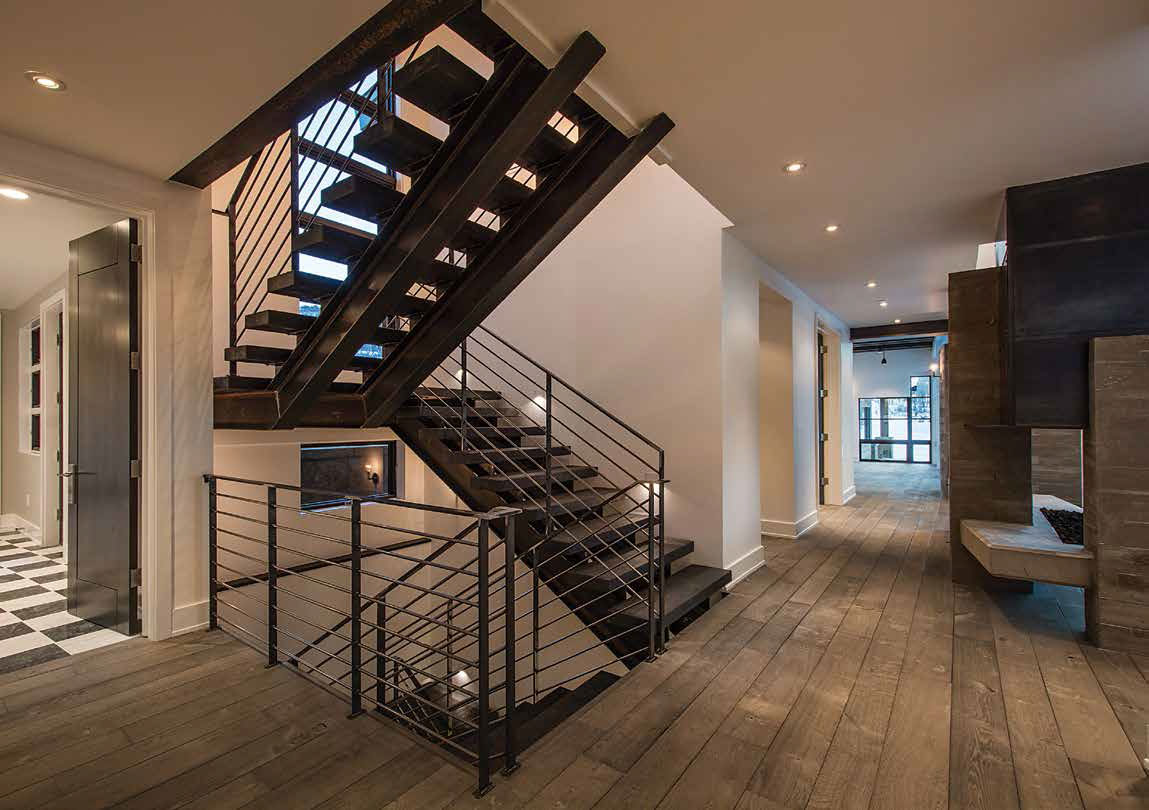STEEL MOVES INTO HOMES
ANN ZIMMERMAN
STRONG, SUSTAINABLE, SAFE, AND ENABLING BOLD DESIGNS AND STRIKING ACCENTS, STEEL IS BECOMING AN ACCEPTABLE AND VALUED MATERIAL FOR BUILDING PARK CITY’S LUXURY MOUNTAIN HOMES.
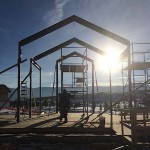
If I were to rewrite the tale of Three Little Pigs today, the wisest pig would opt to build his home from steel. With steel construction, the wee pig could lavishly entertain his pig brothers in the expanse of an open floor plan supported by strong overhead steel beams; he can vigilantly stand lookout for the wolf from a stunning cantilevered deck reaching over the hillside supported by steel; he would find the huffs and puffs of the wolf entirely inconsequential because steel construction can withstand hurricane-force winds.
Steel for residential construction has come of age. First gaining acceptance as a material for high-rises and commercial buildings, steel’s entry into residential construction is recent, but professionals are now rapidly experimenting and developing interesting new applications.
As recently as 1995, steel was considered a new and not yet fully accepted residential material when an exploratory examination of steel in residential construction by the Department of Housing and Urban Affairs concluded that it was a valuable material. According to that report, steel framing is easily adapted to difficult architectural details, such as arched or vaulted ceilings; plumbing and electrical trades adapt to steel framing with little apparent cost impact; and fastening techniques and products were increasingly available to increase productivity.
Go West Development, a graduate engineer and contractor Allred Construction, started building residences with steel in 1980, well
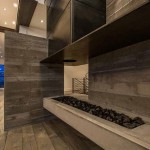
before the HUD report and most residential steel construction in the country. “My first residential project using steel was a new condominium complex in Park City with underground parking. It was very complex structurally. The snow loads, drift loads, and seismic issues were too much for wood to handle, so steel supports the structure,” Allred recalls.
Despite the relative recent interest in building homes with steel, steel isn’t a new material. It was invented some 4,000 years ago and manufactured in brick furnaces. The process combines iron with carbon (about two percent of its weight) and sometimes metal alloys like nickel or chromium are added to resist corrosion. A progression of processes advanced steel making, but it remained expensive until the Industrial Revolution when it could be mass-produced with the Bessemer process, a system that blows air through the molten iron to remove impurities. Further advancements in the Post-WWII period replaced air with oxygen for the Basic Oxygen Steelmaking (BOS) process and refinements like cold-rolled steel. Now, manufacturers produce 1.3-billion tons of steel annually worldwide.
PARK CITY OPTS FOR STEEL
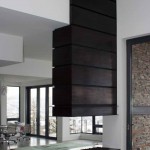
The homebuilding industry has now widely embraced steel. Having gained familiarity with steel through commercial projects, architects and builders are recognizing new applications for residences. This coincides with the shift to contemporary and modern designs, large open living plans, connections to outdoor living, and the green building movement.Park City builder Preston Campbell of Go West Development first used steel in a Park City home in 2005. “It was the first really modern home in Park City since about 1952, and the design had a floating glass staircase,” Campbell recounts, describing how he worked with Scott Benson of Innovative Iron to weld a steel support system that extended from basement to roof during the framing stage. “Scott told me they had never done a floating staircase like this one before, which is our favorite thing to hear, but quickly added, ‘Let’s figure out how to do it.’ The engineers suggested a basic design and gauge of steel, and Scott added to that to ensure there wouldn’t be any flex at all. It worked out perfectly, and looks as good today as the day we finished it.”
For Mike Allred, owner of Allred Construction, steel is a logical building material for Park City. “The slopes of Park City’s building sites are challenging, and the use of more and larger windows for capturing views make building these homes structurally demanding. Steel moment frames have the strength to resist uplift and overturning forces that a structure experiences during an earthquake. Without this kind of construction, there wouldn’t be the home designs we see today.”
VERSATILITY IN DESIGN
Steel’s versatility in design is yet another factor for bringing steel to the forefront. Its product consistency and strong performance characteristics allow for straight, clean, minimal lines and maximizing the use of glass.
According to Preston Campbell, Go West Development uses more steel every year because its strength has opened up design possibilities
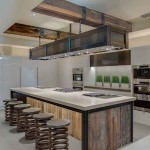
that never existed with traditional framing. “We use steel for the support it offers for building big open floor plans. Flat roofs, which are becoming more prominent design features in this area, can also require extra steel to withstand the added snow loads. Another freedom steel affords us is releasing the architects from stacking walls.” When asked what he means,
he clarifies, “Stacking walls is repeating the same floor plan in the floor below because of the added strength of the aligned walls. Steel allows for more freedom in the room arrangement and sizing.” Another benefit of steel, according to Campbell, is building outdoor living spaces that project out from the home. “By using supporting steel beams that extend deep under or inside the standard framing, we can build cantilevered decks that seem to float in space,” Campbell describes.
According to Mike Allred, steel construction is key to the use of disappearing, lift-and-slide doors that can open as wide as 24 feet for spacious connections to outdoor living. “A wood support beam would have to be huge to support this span. Steel dramatically reduces the height and width of the beam and it is sleek—it does not overtake the design.”
DECORATIVE USES
The use of steel for residences is not limited to structural support. Decorative innovations for steel seem red hot as far as style. Even in mountain landscapes, gabion walls are a sought-after application where steel or iron mesh hold loose rocks in place for a perimeter wall.
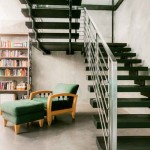
With a sole focus on ornamental iron, Scott Benson founded Innovative Iron in 2004. “I grew up welding,” Scott recalls. “In the past, we’ve primarily worked on stairs and railings, specializing in curved and spiral staircases.
With the growing demand for contemporary homes, architects and designers have seen the potential of steel and iron, and are now designing homes with metal fireplace surrounds, full-wall wraps, landscape retaining walls, waterfalls, range-hoods, furniture, vanities, and many other one-of-a-kind pieces.” Benson continues, “Innovative Iron often uses the TIG (tungsten inert gas) welding process because the TIG torch and dip rod method is highly meticulous and very clean with the added safety benefit to the jobsite of fewer sparks. Additionally, we polish surfaces instead of just grinding them, resulting in a better all-around look.”
Go West Development counts on Innovative Iron to help them move towards what they call “truth in architecture,” says Campbell. “There is an honesty where the design showcases the material’s natural appearance and doesn’t clad it or hide the structure in any way. We can have a steel girder running through the home and out to the exterior. The support is visible and the characteristics of the steel are evident. The challenge is heat gain and loss, but we have figured out how to minimize that.”
According to Campbell, another reflection of truth in architecture is the use of steel as an interior finish material and even as exterior cladding. “We will use panels as thick as a half-inch. Because of the weight, we often place it by crane during the framing stage. It’s beautiful as part of a fireplace, or even as the skin of a house. Different patinas are available, so we aren’t limited to how the panels look, and maintenance is reduced to almost nothing.”
With the trend toward rustic modern, steel works well set against rustic wood, or conversely, oxidized steel adds the rustic
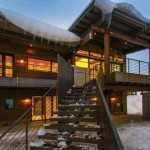
aspect against sleek or polished surfaces. In modern homes, steel can be found in rails, balustrades, crown moldings, and toe kicks. There is also a retro return to polished finishes using steel combined with chrome and nickel alloys. Preston Campbell uses coatings to control the oxidation on exterior steel panels for interesting colors. “The earth tones give it an organic feeling that makes it seem like it has been there a long time and maybe bubbled up from the ground.”
“Innovative Iron is changing the look of iron in homes,” Scott Benson explains when asked about treatments. “Finishing iron has gone far beyond painting and powder coating. With patinas, stains, wax, and other coatings, we’re able to give every piece a unique look. Pieces fit well and look their best in homes because of how closely we work with masons, carpenters, and glassworkers.”
Wyatt McDaniel of Peppertree Kitchen and Bath works on some of the most daring new kitchen designs in Park City and the Wasatch Front, and he has seen a steady progression in the use of steel. “It began with stainless steel in outdoor kitchens, and now stainless has moved inside. I see a continuing and growing trend to use stainless steel in kitchens. A recent kitchen design comes to mind that incorporates a large stainless steel cylinder.”
McDaniel continues, “Hot-rolled steel has now taken its place as another important material in kitchen and interior design. The look of exposed steel is very raw, and it blends very well with the earth tones of barn wood and stone. In kitchens, we have used hot-rolled steel in range hoods, end pieces, trim, shelves, and doors on fridges. Homes incorporate flat-rolled steel as full wall panels, surrounds, and accent panels, and fireplaces combine steel with natural stone. Uses like these create an industrial contemporary look that’s new and refreshing.”
When asked about steel as a product for remodels, McDaniel answers, “We can incorporate steel into the cabinet design and the range hoods. Steel appliances can easily update a kitchen.”
POINTS FOR SUSTAINABILITY
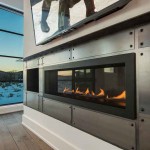
For a number of reasons, steel is considered sustainable and a useful material to assist with green building certification. Often compared with the wood products it replaces, steel is completely recyclable. In contrast to other recyclables like paper fiber, there is no limit to the number of times steel may be recycled without a loss of quality. Because steel is often prefabricated in the factory, it is cut to precise dimensions for less waste at the job site, and the cuttings at the factory are standard sizes that can be welded together for new pieces, again creating less waste. Additionally, any waste at the factories has extremely high rates of recycling. Go West Development likes to source recycled steel when possible, which also has the benefit of extra points on LEED’s scoring. When steel is used for roofing and prepainted a light color or granular coated, it reflects light and heat to save on cooling costs. And, as an additional environmental benefit, according to the American Iron & Steel Institute (AISI), the required energy for today’s steel production dropped 28 percent from 25 years ago.
SAFER AND LONG-LIVED
One of steel’s other touted benefits is that it is safer. Compared to wood, it resists termites and fire. Experts at World Steel
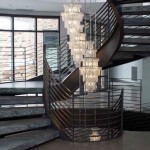
offer factsheets as to its superior wind resistance and ability to withstand earthquakes. According to AISI, steel has the highest strength to weight ratio of all building materials, and this affects the cost of transportation and the volume of space that support materials occupy in the home.
Mike Allred agrees that steel is also the preferred building material to resist earthquake loads, an important consideration for the Park City area.
“The most creative and ‘green’ thing we can do is to build a home to last forever and without a lot of maintenance,” says Preston Campbell. “The more steel we can use, inside and out,
the longer our homes will last.” { whj
